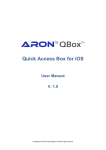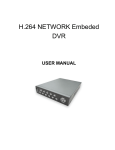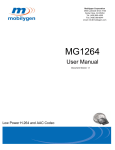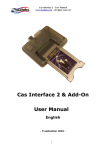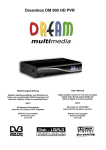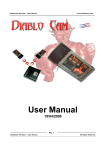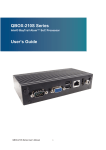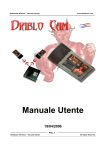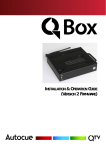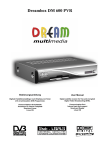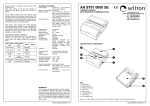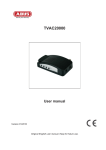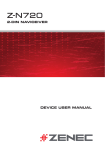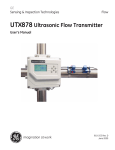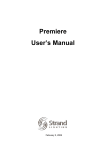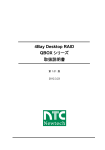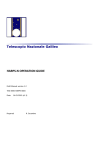Download QBOX Manual
Transcript
www.q-box.tv Quick User Manual Digital satellite receiver for free and encrypted Digital Video Broadcasting (DVB). Communication-Port Internal hard disk support. Two Smartcard Readers Linux OS For Full User Manual please refer to www.q-box.tv The QBox one carries the CE-Sign and fulfills all requirements from the EU. Software: Release 1.5.2 on 15-09-2008. Subject to change without prior notification. Before initial operation on the receiver Safety instructions Please read the safety instructions completely and carefully, before using the Q-Box. The Manufacturer takes no responsibility for damages as a result of incorrect handling of the QBox. - The safety marking is located on the exterior of the bottom of the apparatus. - The mains plug shall be installed near the equipment and shall remain readily operable. - Allow enough space around the QBox for sufficient ventilation. - Do not cover the top of the QBox and allow enough space to other devices. The louvers of the devices must be free at all times to allow sufficient heat transfer from inside the device. - Never put vases or any other liquid filled containers on top of the device. Do not expose the device to dripping or splashing liquids. - Do not place open flame sources, such as lit candles, on top of the device. -The device may only be operated in moderate climate. - Do not remove the cover. Risk of electric shock. If it is necessary to open the device please contact a trained professional. -Do not put any metal things into the slots or ventilation openings. -The installation of a hard disk is only allowed by skilled personal or your local dealer. Modifications and changes to the QBox lead to loss of warranty if not performed and documented by skilled personal. We recommend the installation of a hard disk by your local dealer. Unskilled installation of a hard disk leads to loss of warranty. Shut down - In case your QBox is not in use for a long period of time disconnect the power plug from the power outlet. - During thunder storm the unit should also be physically disconnected from the power outlet. Additional safety instructions - (Dis-)Connecting to a LNB: Turn the QBox off before you connect or disconnect a cable coming from or going to a LNB. - Connecting to a TV: Before connecting or disconnecting your QBox to/from a TV please turn it off. - In case you notice any damage to the power cord or power plug immediately disconnect the device from the power outlet. - In case the device was exposed to humidity immediately disconnect the device from the power outlet. - In case you notice any serious damage to the outer shell of the device immediately disconnect the device from the power outlet. - Do not expose the QBox to direct sunlight, lightning or rain. - Grounding: The LNB cable must be grounded. The grounding system must meet SABS 061 requirements. - Cleaning: Disconnect the mains power cord before cleaning the cover. Use a slightly damp cloth without cleaning agents. - Connect the QBox only to suitable sockets. Do not allow overloads to occur. - Please be careful that the batteries of your remote control are not exposed to heat, since they might explode. Disposal instructions The packaging of the QBox only consists of reusable materials. Please recycle if possible. This symbol on the product or on its packaging indicates that this product must not be disposed of with your other household waste. Instead, it is your responsibility to dispose of your waste equipment by handing it over to a designated collection point for the recycling of waste electrical and electronic equipment. The separate collection and recycling of your waste equipment at the time of disposal will help to conserve natural resources and ensure that it is recycled in a manner that protects human health and the environment. For more information about where you can drop off your waste equipment for recycling, please contact your local city office, your household waste disposal service or the shop where you purchased the product. Please note that empty batteries and electric waste is not to be put into the regular garbage. CE Certification Duolabs S.p.A. declares that this equipment complies to essential requisites and other relevant provisions of Directives 2006/95/CE (“low voltage”) e 89/336/CE (“electromagnetic compatibility”). For Wi-Fi sold models. Duolabs S.p.A. Declares that this equipment complies to essential requisites and other relevant provisions of Directive 1999/5/CE (“ Radio and Telecommunications Terminal Equipments”). The declaration of conformity may be required to Duolabs S.p.A., via Baggi 28, 36061 Bassano del Grappa (VI). The use of the radio interface may be subjected to local restriction of use. Customers are responsible for verifying approval for use in their individual countries. Please consult your local spectrum authority. http://ec.europa.eu/enterprise/rtte/spectr.htm Packaging contents Please check the completeness of the box’s contents. Included in box: Qbox One Remote Control Batteries (1,5V Mignon / AA / LR6) Power Supply 12Volts 1 IDE-Cable (already installed inside the device) 1 User manual Power Cord Front View Smartcard Readers Satellite Antenna Input/Output Terrestrial Antenna Input/Output USB Port Scart Input & VCR Output Video /Audio Output USB Port Power Supply Rear View Serial Communication Ethernet Communication Digital Audio Output Reset Button Power Supply Input Explanation Front Panel Double Smartcard Reader Insert your Smartcard with the golden chip facing down and forward into the Smartcard reader. Standby LED The Standby LED lights up red if the QBox is in standby mode. It lights up green if the QBox is powered on. Remote Control (RC) Led The remote control LED lights up every time the QBox receives a signal from the remote control. Standby on/off USB Port The USB port will handle the PVR and other functions. In this port you can insert only USB compatible devices such as PEN sticks or USB Hard Disks. Explanation Rear Panel Video output (FBAS) You can optionally connect your QBox to a TV using a RCA/Chinch cable. (Composite) Audio output - analog (Cinch) Connect your QBox with a RCA/Cinch cable to your HiFi-Amplifier (e.g. AUX In or Tape In ports). Serial interface (RS232C, Sub-D, 9-pin) The Serial Port is used to update the operating system. Please connect a serial null modem cable here. TV Scart Connect your TV or beamer to your QBox using a Scart cable. Audio output SPDIF - digital (Toslink) You can connect your Qbox with an optical (Toslink) cable to your HiFi-Amplifier or DSP. The AC3 signal is also available at this port in case the selected channel transmits Dolby Digital signals. Power supply connector Plug the power cable of the power supply that came with your QBox into power outlet. Connect your power supply to your Qbox. You must not connect the power plug of the power supply to anything other than a socket that supplies 230V/50Hz. Network interface (Ethernet 10/100Mbit, RJ45) The Communication Port is an Ethernet port. It is used to communicate with your QBox via HTTP, FTP, NFS, Telnet and Samba. This port is also used to update the operating system of your QBox. Please use a regular patch cable to connect your QBox to your LAN. The factory set username and password to get access to the QBox are: Username: root Password: qboxqbox USB Port The USB port will handle the PVR and other functions. In this port you can insert only USB compatible devices such as PEN sticks or USB Hard Disks. Important notes about operation All functions of the QBox can be controlled via OSD-Menu (On-Screen-Display). This makes the handling of the QBox very easy for you. All options are indicated by four colored dots or beams (red, green, yellow, blue) in the OSD-Menu and can be started with the Option-Buttons on the Remote Control. Depending on the chosen Menu, these options do change. The Options-Buttons of your remote control have multiple functions. You will notice control symbols below the four colored Options-Buttons, the TV- and the RADIO-Button. In PVRMode these buttons are used to control the digital recording according to their symbols. Pressing the VIDEO-Button on your remote control will activate the PVR-Mode. The Infobar will also indicate this. It changes from showing the channel information to showing the control symbols for the PVR-Mode. (also see Instant recording) In general the menus are controlled using the Navigation-Buttons on your remote control. All Menus and Service lists are closed with the EXIT-Button. Menu Button If you are in TV- or RADIO-Mode, pressing this button will bring up the OSD main menu. The OSD main menu has the following options: -(1) TV Mode -(2) Radio Mode -(3) File Mode -(4) Information -(5) Shutdown -(6) Setup -(7) Games -(8) Timer You can switch to the needed option by pressing the Navigation-Buttons left or right. Also see: Important notes about operation. The numbers in front of each option can be used to directly access the needed function by pressing the according number on the Numeric Keypad of your Remote control. If you are in the service list, pressing the MENU-Button brings up the service menu. The shown options may vary depending on the service list you selected. The Power-Button switches your QBox on and off. See chapter Turning your Qbox on and off. The TV-Mode-Button switches your remote control into TV control mode to control your preprogrammed TV. It will shortly light up once your press the button. See chapter TV-Mode setup. Enter a service number to directly access the option by using the Numeric Keypad. The service numbers are on the left side of the service list. The Numeric Keypad can also be used to enter the teletext page number when you are in TV-Control-Mode and if your TV is teletext capable. The TV station has to submit teletext information; otherwise this feature cannot be used. Pressing the MUTE-Button mutes the Volume. A crossed speaker symbol will appear on the TV screen. Pressing it again or pressing one of the Volume +/- Buttons brings back the audio. You can leave all menus and service lists by pressing the EXIT-Button. By pressing the OK-Button you confirm a selection in the menu or service list navigation. If no OSD menu is present on your screen, the infobar is shown once you press the OK-Button. In general the menus are controlled using the Navigation-Buttons on your remote control. To get into a submenu you have to press the OK-Button. The Volume +/- Buttons control the volume of the audio. Pressing + will make turn it up and pressing - will turn it down. By pressing the AUDIO-Button you can choose the different audio tracks offered by the station. Pressing the VIDEO-Button activates the PVR-Mode. The Infobar will show the control symbols. You can instantly start recording by pressing the Radio-Button on your remote control. You can also toggle between single-, doubleand trible-column-view in the service list. All possible options are shown by the four colored dots/blocks (red, green, yellow, blue) and can be activated by the Options-Buttons. In PVR-Mode these buttons are used to control the digital recording. Depending on the menu you currently are in the options will change and will be named differently. Pressing the TV-Button activates the TV-Mode. Pressing the RADIO-Button activates the RADIO-Mode. The TEXT-Button activates the Teletext (TuxTxt). If you are in the stations list, pressing this button will directly take you to the FILE-Mode. Pressing the HELP-Button activates the Help menu. Installation Turning the device on - Turning the device on - Insert 2 AA (1,5V) batteries, taking care to observe the + and - markings indicated inside, into the remote control. - Before using the QBox, please read the safety instructions. - Connect the LNB or antenna with a coaxial cable to LNB or Antenna In at your QBox. - Connect the QBox with a Scart cable to your television screen. - Plug in the power cable into a 230V/50Hz power socket. - If you are using a switchable power socket please shutdown your QBox into deep standby before switching off the power socket. - If you switch on your QBox for the first time, you will see the setup wizard. The setup wizard will guide you through the first time installation. You will be asked for your TV standard, the regional settings and your language. Please choose and follow the instructions on the screen. - Please note that the video format meets the factory setting CVBS (FBAS). From here on, please follow the instructions on the screen. For some special features regarding the non-standard ENIGMA functions please refer to the appendix on this user guide. For full detailed information refer to the full User Manual Downloadable from the official QBox web site: www.q-box.tv Appendix 1 - Dedicated Functions for QBox To get access to some special functions of your QBox you need to enter the Plug-In menu by pressing the blue button on your Remote Control Plug-In button e Choose QBox manager and press OK QBox Manager Functions Remove HDD – This function is needed to change the HDD for PVR from Internal HDD to External HDD or vice versa. You need to install the previously installed driver and install the other one you want to use. Use Internal HDD - This function is needed to mount the internal HDD for PVR. You need to run Remove HDD function in case you have had previously installed the External HDD on USB. Use External HDD on USB - This function is needed to mount the External HDD for PVR. You need to run Remove HDD function in case you have had previously installed the Internal HDD. Create Backup to USB - This function will create a backup file of your system configuration into a USB Pen or external HDD. Restore Backup from USB - This function will restore a backup file of your system configuration from a USB Pen or external HDD. Other functions will be explained on the next pages. Terrestrial Scan Setup Find Terrestrial Channels – If your QBox is provided with DVB-T tuner (please check out your system configuration) it will start scanning the pre-installed frequencies of Terrestrial Transponders. If some services are not found you can either do a Manual Frequency Scan. As it will follow on the next slide. Once the Scan is completed a Scan report will show up. Manual Terrestrial Transponder Scan – With this function you can manually scan each Terrestrial specific frequency in case the automatic scan will skip it or it is simply not listed. Enter the Menu button: Setup <OK> Service Searching <OK> Manual Transponder Scan <OK> Move with the Remote Control over the frequency and set the first 2 digits to 12 and on the other 3 digits set the frequency you want to scan like in the example 826. Set the Symbol rate to 00800 this will tell the STB to set the terrestrial tuner. Let all the other settings as is. Press <Start Scan> button. Must be 12 Set to 00800 for Terrestrial Scan Frequency to scan in Mhz Scan Completed. When the scan will be completed a report of found channels will be prompted on the screen. Wi-Fi connection Setup Configure WiFi – If your QBox is provided with Wi-Fi module (please check out your system configuration) you need to enable the Wi-Fi interface simply pressing on Enable Wifi Interface area. And the new menu will appear. Configure WiFi – Once you Enable Wifi Interface it will come up with the possible options for IP configuration. You can choose between a Static IP or a Dynamic IP. Scan SSID: This function will scan the WiFi Access Point in the area. It will show up the found services in the box. Encryption – Once you enabled the Encryption WiFi interface. You will be prompted with the possible options for Security Encryption protocols configuration: • None: No Encryption • WEP 64/ WEP128: WEP Encryption 64 or 128 bit. WEP 64bit (HEX) (5byte) WEP 128bit (HEX) (13 byte) • WPA- PSK TKIP: WPA encryption. WPA (min 8 max 63 ASCII chars) • WPA2-PSK CCMP-AES: WPA2 encryption. WPA2 (min 8 max 63 ASCII chars) Please make sure you enter the correct encryption keyset matching with the same keyset in your Router or Access Point. Blind Scan Function What’s Blind Scan? – Blind Scan is a special function which allows the user to scan in a blind way for hidden temporary satellite feeds. This function is in QBox hardware performed. How to get started – Choose Blind Scan from the QBox manager and then set the following parameters: • Start Frequency: Range must start from 10.700 Mhz • End Frequency: Range must end at 12.750 Mhz • Step Frequency: This is the Mhz step by which the Blind Scan will scan for Transponders. Please mid that as big as the step will be (Max 15Mhz) at faster the search will be as less channels it can be possibly detect! Once you are done with the settings you can: • Start Scan • Stop Scan • Erase All Feeds • Check the signal strength When you finished scanning all the found channels will be stored in Feeds favorite folder and in the Main Channels List folder. Once you press the Erase All Feeds button all channels will be erased from the Feeds folder and the Main Channels List folder. Quick user guide www.q-box.tv All rights reserved















